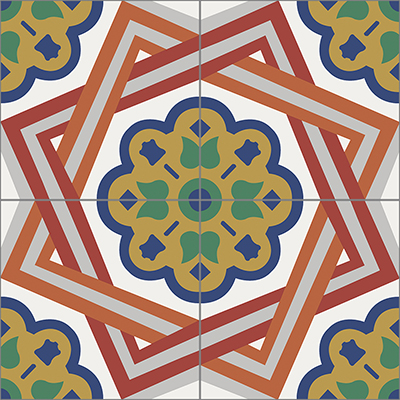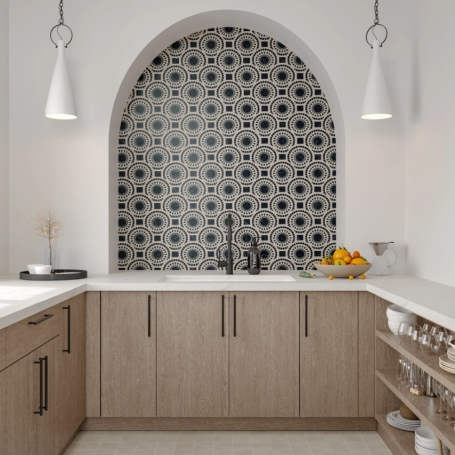
Unveiling Timeless Mosaic Tile Patterns: A Journey Through Elegance
February 6, 2024
Tiles have come a long way from their utilitarian past, and today, mosaic tile patterns stand as a testament to the evolution of design. As we delve deeper into the world of intricate and alluring mosaics, we aim to unveil the beauty and charm of patterns that have stood the test of time. The allure of these designs not only lies in their aesthetic appeal but also in the stories they carry with them, transcending eras.
Why are Mosaic Tile Patterns Still Trending?
Mosaic tiles have been around for centuries, captivating homeowners, designers, and architects alike. The question is, what makes them perpetually enchanting? First, the timeless patterns in different colors offer a rich blend of history and artistry, setting them apart from fleeting design fads. Second, their unmatched versatility allows them to be easily incorporated into various design aesthetics, whether it’s a modern minimalist home or a Bohemian-inspired space.
The durability of mosaic tiles also plays a pivotal role. Beyond their visual charm, porcelain and ceramic mosaic tiles are built to last. Many ancient architectures still flaunt their original mosaic tile designs, a testament to their enduring nature. In an age of sustainability, what can be better than integrating design elements that never go out of style and stand robust through generations?
Exploring the Classics: Most Popular Mosaic Patterns

The Herringbone Saga
The herringbone pattern, characterized by its distinctive V-shaped weaving, can trace its roots back to ancient Roman architecture. Its name is derived from its resemblance to the skeleton of the herring fish. This timeless mosaic tile pattern is loved for its ability to add depth and dimension to any space.
Today, herringbone is embraced in kitchens as backsplashes, on living room floors, and even in outdoor patios to create visual interest. Whether you’re aiming for a rustic look using a tile material like natural stone or a sleek appearance with polished marble, the herringbone pattern seamlessly fits the bill.
Tales of the Hexagon
Hexagonal patterns have been a favorite for ages. Often associated with nature, especially the honeycomb, this geometric design offers a harmonious blend of symmetry and style. One cannot ignore the appeal of hexagonal mosaic tile patterns when aiming for a design that’s both trendy and timeless.
Its six-sided geometric shape allows for a myriad of combinations and layouts. From monochromatic schemes to a riot of colors, hexagons can adapt and dazzle. They’re a perfect choice for those looking to create a focal point in their spaces.
Chevron: The Timeless Arrow
Easily confused with herringbone, the chevron pattern stands distinct with its continuous zigzag design. Originating from ancient Greece, where it adorned pottery and architecture, its legacy remains strong. A space adorned with chevron mosaic tiles exudes dynamic energy.
Modern homes have adopted the chevron pattern in various hues and materials. A black and white chevron backsplash, for instance, can be the centerpiece of a contemporary kitchen. Conversely, a wooden chevron floor can infuse warmth into a cozy living room.
Incorporating Timeless Mosaics in Contemporary Designs

Even as design trends come and go, mosaic tiles effortlessly find their place in contemporary homes. One might wonder how? It’s their inherent flexibility and charm. A classic herringbone or chevron pattern can be paired with modern fixtures and furnishings, resulting in a space that’s both nostalgic and nouveau.
Moreover, the choice of material and color can redefine the entire vibe of the pattern. Imagine a hexagonal pattern in rose gold hues or a herringbone design using reclaimed wood. The possibilities are endless, and the results, always enchanting.
14 Design Tips for Using Mosaic Tiles in Your Home

Mosaic tiles have captivated homeowners for generations, with their intricate details, myriad colors, and the undeniable charm they bring to any space. When used thoughtfully, they can transform even the most mundane corner into a visual delight. However, like any design element, mosaics require a discerning eye to ensure their full potential is realized. Here are some design tips to consider when integrating mosaic tiles into your home:
- Harmonize with the Overall Decor: When selecting mosaics, consider the overarching style and color palette of your home. A bohemian-themed room might benefit from vibrant, mixed-pattern mosaics, while a minimalist space may be best complemented by monochromatic or subtly-patterned tiles.
- Less is Often More: Mosaics are inherently intricate. This means they can easily dominate a space, potentially making it feel cluttered. To avoid this, use mosaics sparingly. For instance, in a bathroom, you might use mosaics for a feature wall or a border, leaving the rest of the space more neutral.
- Scale and Size Matter: The size of the mosaic tiles should be in proportion to the space they’re applied. In larger rooms, bigger tiles or a mix of sizes can work, while smaller spaces might benefit from smaller tiles to give a more refined texture without feeling overpowering.
- Create Focal Points: Use a custom tile pattern to draw attention to specific areas or features in a room. A vibrant mosaic backsplash can be the centerpiece of a kitchen, or a mosaic-clad fireplace can become the living room’s main attraction.
- Transition Gracefully: If you’re using mosaics alongside other types of tiles or different materials, ensure there’s a smooth transition. This can be achieved by using transitional tiles, like pencil liners, or ensuring the color tones of both materials harmonize well.
- Explore Different Shapes and Patterns : Beyond the traditional square tile and hexagonal tile shapes, mosaics come in varied patterns like herringbone, chevron, and basketweave. These mosaic designs can influence the room’s vibe, adding dynamism, elegance, or playfulness.
- Consider Maintenance: Mosaics, especially those with many grout lines, can be harder to clean. In high-traffic or wet areas like a laundry room or shower floor, ensure you seal the grout to avoid stains and make maintenance easier.
- Use as Accents in Larger Areas: In vast spaces, like a big living room floor, mosaics can be interspersed as decorative accents among larger tiles. This breaks the monotony and adds an unexpected touch of intricacy.
- Play with Grout Colors: The grout color can dramatically change the mosaic’s appearance. A contrasting grout will make each tile stand out, emphasizing the pattern, while a matching grout offers a more seamless look.
- Mosaics Aren’t Just for Floors and Walls: Think beyond traditional applications. Porcelain mosaic tiles can adorn tabletops, be integrated into furniture designs, or even serve as framed art pieces.
- Consistent Thickness: When pairing mosaics with other tiles, ensure each individual tile has a consistent thickness. This ensures a smooth surface, especially important for floors to avoid tripping hazards.
- Factor in Lighting: Light can enhance the beauty of mosaics. Under-cabinet lighting can illuminate a kitchen backsplash, while a well-placed spotlight can emphasize the shimmer of glass mosaics in a bathroom.
- Mix Materials with Care: Mosaics come in various materials, from ceramic and porcelain to glass and natural stone. Each has a unique aesthetic and texture. While mixing materials can add depth and interest, ensure they harmonize in terms of color and style.
- Stay Flexible: Remember, trends come and go. While it’s tempting to adopt the latest design fad, consider the longevity of your choice, especially for significant installations. Classic designs or personal preferences that you truly love tend to stand the test of time.
Incorporating mosaic tiles into your home design can elevate the aesthetic appeal manifold. Whether you’re aiming for a touch of vintage charm, a modern edge, or a nature-inspired tranquility, mosaics offer a world of possibilities. The key lies in thoughtful design choices, ensuring that the mosaics enhance the space’s beauty without overwhelming it. With these design tips in mind, you can harness the full potential of mosaic tiles, crafting spaces that resonate with charm and personality.
FAQs About Mosaic Tiles:
- Why choose Timeless Mosaic Tile Patterns over modern designs? Timeless designs offer a blend of history, artistry, and versatility. While modern patterns may fade out with changing trends, timeless patterns remain eternally stylish. They also carry stories from the past, making them unique and soulful.
- Are Timeless Mosaic Tile Patterns expensive? The cost largely depends on the material and craftsmanship. While some timeless patterns using premium materials might be pricey, there are cost-effective options that don’t compromise on aesthetics.
- Can I use Timeless Mosaic Tile Patterns in my small apartment? Absolutely! These patterns, with their intricate designs, can make spaces look larger and more elegant. For smaller spaces, choosing lighter hues can enhance the feeling of spaciousness.
- How do I maintain and clean my mosaic tiles? Regular cleaning using mild soap and water is generally recommended. For specific materials like marble or natural stone, it’s advisable to consult with the tile manufacturer for care instructions.
- Can these tiles be used outdoors? Yes, many timeless mosaic patterns are suitable for outdoor use, especially if they are made from durable materials like porcelain or certain natural stones. Ensure they are properly sealed to withstand outdoor elements.